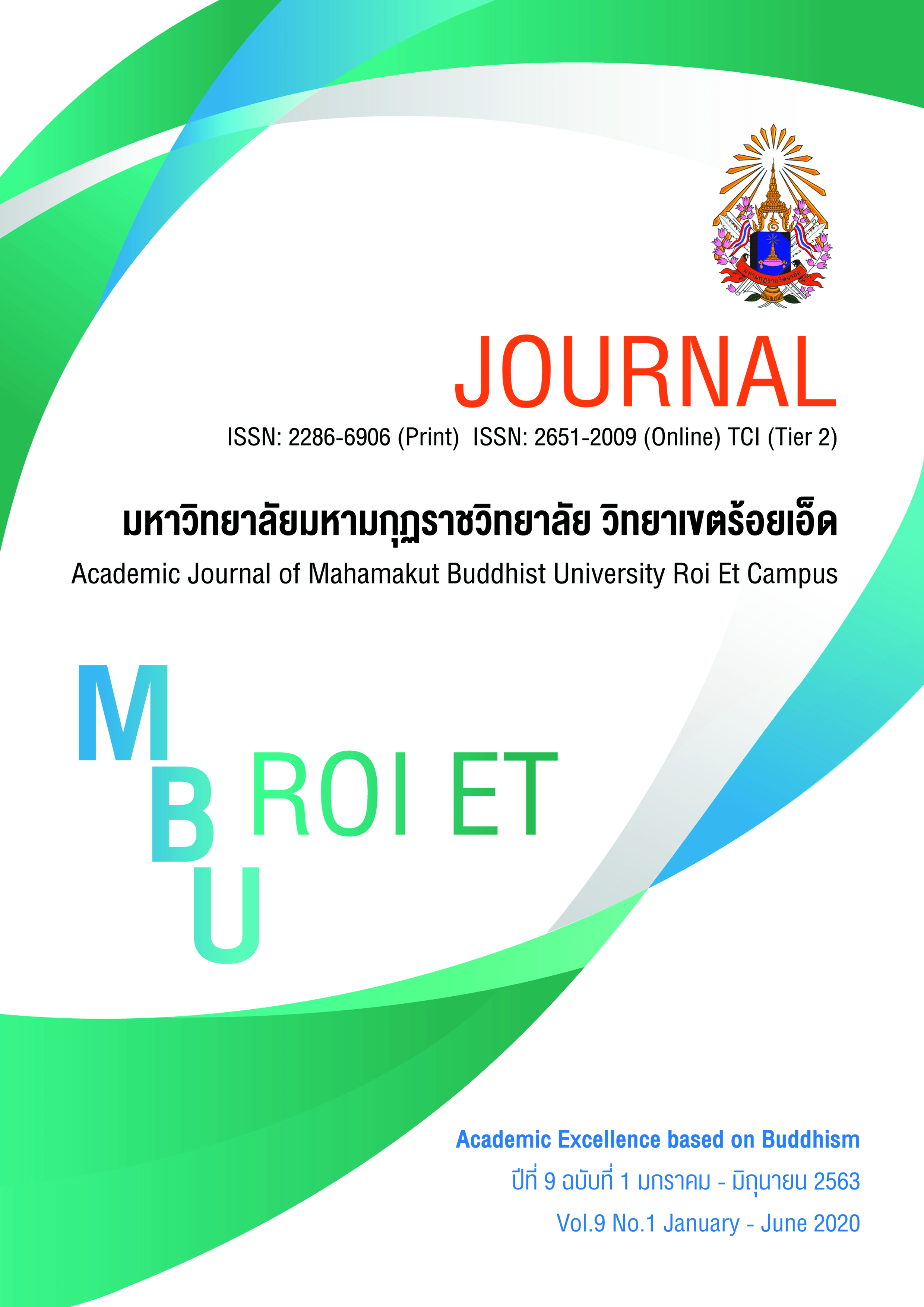A Model for living a Self-Reliance Way of life Based on the Buddhist Principle of Right Livelihood to Develop the Quality life of the Farmers in the Central Northeastern Region
Main Article Content
Abstract
The objectives of this research were to create and develop a self-living model based on the principle of Right Livelihood in order to develop life quality of farmers living in the central northeastern region of Thailand and the model created being tested with the target group to ensure its effectiveness. The testing process began with the workshop having been arranged for 40 farmers living in the central Northeastern provinces, of which ten each were selected from Roi Et, Mahasarakham, Kalasin and KhonKaen. The test result was analyzed to find its quality and validity so that the model would be developed more effectively.
The results of the study were as follows: The model that has been created and developed consists of 3 factors. They are 1. Life maintaining, 2. Livelihood operating and 3. Application. It was also found that the sustainable development of life should be based on the philosophy of Sufficiency Economy and royal technology originated by the late King Rama IX. And the following 5 virtues and 9 measures should be practiced. The five virtues are 1. Trust, 2. Braveness, 3. Unity, 4. Knowledge and 5. Social norms, and the 9 measures comprise the following: Being sufficient 1. to eat, 2. to use, 3. to survive, 4. for well-being, 5. to do good, 6. to give, 7. for saving, 8. to sell and 9. to perform in a network. And The model that had been applied and its effectiveness was found to enhance with statistical significance at .05.
Article Details
References
นภาพร อติวานิชยพงศ์. (2557). คนชนบทอีสานกับการทำมาหากิน:ความเปลี่ยนแปลงตามยุคสมัย. วารสารสังคมวิทยามานุษยวิทยา. 33(2). 103-127.
นภาพร อติวานิชยพงศ์. (2557). หนึ่งทศวรรษสังคมอีสานผ่านมุมมองบัณฑิตอาสาสมัครมหาวิทยาลัยธรรมศาสตร์. ใน นภาพร อติวานิชยพงศ์ กนกวรรณ ระลึก และกนกวรรณ แซ่จัง ชุดโครงการวิจัยสังคมชนบทไทยในมุมมองบัณฑิตอาสาสมัคร : บทสังเคราะห์องค์ความรู้จากงานศึกษาของบัณฑิตอาสาสมัคร มหาวิทยาลัยธรรมศาสตร์. โครงการวิจัยโดยการสนับสนุนจากกองทุนวิจัยสำนักบัณฑิตอาสาสมัคร มหาวิทยาลัยธรรมศาสตร์ ประจำปี 2556 : มหาวิทยาลัยธรรมศาสตร์.
นิธิ เอียวศรีวงศ์. (2557). ชนบทนิยมในการเมืองไทย. มติชนสุดสัปดาห์ (28 พฤศจิกายน –4 ธันวาคม 2557). 5-11.
ปณิตา คุ้มผล. (2552). โรคพิษจากสารกำจัดศัตรูพืช. Annual Epidemiological Surveillance Report 2009. ISSN 0857-6521. สืบค้นเมื่อ 22 สิงหาคม 2561. จาก http://epid.moph.go.th/
พระนิติศาสตร์ ญาณิสฺสโร (สุภาโภชน์). (2558). การศึกษาเชิงวิเคราะห์ทานในสังคหวัตถุตามแนวพุทธปรัชญาเถรวาท. วารสารมหาวิทยาลัยมหามกุฏราชวิทยาลัย วิทยาเขตร้อยเอ็ด. 4(2). 197-208.
พระราชธรรมนิเทศ (ระแบบ ฐิตญาโณ) (2538). ธรรมปริทรรศน์. กรุงเทพมหานคร : มหามกุฏราชวิทยาลัย.
พระสุชีพ วรญาโณ (อินทร์สำราญ). (2558). การศึกษาเชิงวิเคราะห์การพัฒนาคุณภาพสังคมด้วยการงดเว้นจากการดื่มสุราและเมรัยตามแนวพุทธปรัชญาเถรวาท. วารสารมหาวิทยาลัยมหามกุฏราชวิทยาลัย วิทยาเขตร้อยเอ็ด. 4(2). 276-289.
พระอภัย อภิชาโต (ชูขุนทด). (2555). การศึกษาหลักธรรมสาหรับพัฒนาพฤติกรรมของมนุษย์ในสังคมปัจจุบัน. วิทยานิพนธ์พุทธศาสตรมหาบัณฑิต สาขาวิชาพระพุทธศาสนา. บัณฑิตวิทยาลัย :มหาวิทยาลัยมหาจุฬาลงกรณราชวิทยาลัย.
พวงพยอม เหรียญทอง (2541). การประกอบอาชีพแบบพึ่งตนเองของเกษตรกร. วิทยานิพนธ์ปริญญาศิลปศาสตรมหาบัณฑิต. บัณฑิตวิทยาลัย : มหาวิทยาลัยขอนแก่น.
มนตรี แย้มกสิกร. (2550). เกณฑ์ประสิทธิภาพในการวิจัยและพัฒนาสื่อการสอน:ความแตกต่าง 90/90 Standard และ E1/E2. วารสารศึกษาศาสตร์ มหาวิทยาลัยบูรพา. 19(1). 1-16.
มหามกุฏราชวิทยาลัย. (2534). พระไตรปิฎกพร้อมอรรถกถา แปล ชุด 91 เล่ม. กรุงเทพมหานคร : โรงพิมพ์มหามกุฏราชวิทยาลัย.
ฤทัยรัตน์ วรกิจโจดม. (2551). พุทธศาสนากับการมีชีวิตยืนยาว. สารนิพนธ์ศิลปศาสตรบัณทิต(ศาสนศึกษา). วิทยาลัยศาสนศึกษา : มหาวิทยาลัยมหิดล.
วาโร เพ็งสวัสดิ์. (2546). การวิจัยในชั้นเรียน. กรงเทพมหานคร : โรงพิมพ์สุวีริยาสาส์น.
วิวัฒน์ ศัลยกำธร (2561). ทฤษฎีใหม่กับเศรษฐกิจพอเพียง. สืบค้นเมื่อ 22 สิงหาคม 2561. จาก http://agrinature.or.th/node/169
ศิริวรรณ พิริยคุณธร และคณะ. (2557). ประสบการณ์การนำหลักธรรมคำสอนทางพระพุทธศาสนามาใช้ในการดำเนินชีวิตในชุมชนชนบท. วารสารพยาบาลสงขลานครินทร์. 34(2). 39-52 .
เศรษฐวัฒน์ โชควรกุล. (2555). นโยบายการพัฒนาคุณภาพชีวิตผู้สูงอายุขององค์กรปกครองส่วนท้องถิ่นในเขตจังหวัดภาคตะวันออกเฉียงเหนือ. วารสารการบริหารปกครอง. 1(1). 146-165.
อานันท์ กาญจนพันธุ์. (2554). ชนบทอีสานปรับโครงสร้าง ชาวบ้านปรับอะไร. วารสารศิลปศาสตร์ มหาวิทยาลัยอุบลราชธานี. ฉบับพิเศษเสรีนิยมใหม่ในเศรษฐกิจอีสาน(1). 5-41.
อุทัย สถิตมั่น. (2552). เศรษฐกิจพอเพียงภาพสะท้อนแนวคิดพุทธศาสนาเพื่อสังคม. รวมบทความวิชาการทางพระพุทธศาสนา การสัมมนาทางวิชาการนานาชาติ เนื่องในวันวิสาขบูชา วันสำคัญสากลของโลก วันที่ 4-6 พฤษภาคม พ.ศ. 2552. 11-30.
Kearney, Michael. (1996). Reconceptualizing the Peasantry : Anthropology in Global Perspective. Colorado : West view Press.
Woods. Michael. (2011). Rural. London and New York : Rout ledge.


